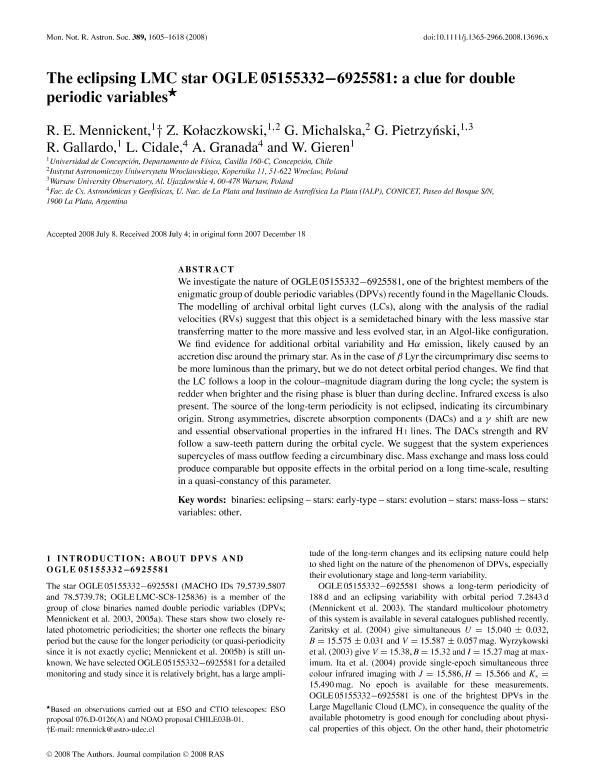Mostrar el registro sencillo del ítem
dc.contributor.author
Mennickent, R. E.

dc.contributor.author
Kolaczkowski, Z.
dc.contributor.author
Michalska, G.
dc.contributor.author
Pietrzyński, G.
dc.contributor.author
Gallardo, R.
dc.contributor.author
Cidale, Lydia Sonia

dc.contributor.author
Granada, Anahi

dc.contributor.author
Gieren, W.
dc.date.available
2018-05-21T14:25:27Z
dc.date.issued
2008-12
dc.identifier.citation
Mennickent, R. E.; Kolaczkowski, Z.; Michalska, G.; Pietrzyński, G.; Gallardo, R.; et al.; The eclipsing LMC star OGLE05155332-6925581: a clue to understand Double Periodic Variables; Wiley Blackwell Publishing, Inc; Monthly Notices of the Royal Astronomical Society; 389; 4; 12-2008; 1605-1618
dc.identifier.issn
0035-8711
dc.identifier.uri
http://hdl.handle.net/11336/45717
dc.description.abstract
We investigate the nature of OGLE05155332-6925581, one of the brightest members of the enigmatic group of double periodic variables (DPVs) recently found in the Magellanic Clouds. The modelling of archival orbital light curves (LCs), along with the analysis of the radial velocities (RVs) suggest that this object is a semidetached binary with the less massive star transferring matter to the more massive and less evolved star, in an Algol-like configuration. We find evidence for additional orbital variability and Hα emission, likely caused by an accretion disc around the primary star. As in the case of βLyr the circumprimary disc seems to be more luminous than the primary, but we do not detect orbital period changes. We find that the LC follows a loop in the colour-magnitude diagram during the long cycle; the system is redder when brighter and the rising phase is bluer than during decline. Infrared excess is also present. The source of the long-term periodicity is not eclipsed, indicating its circumbinary origin. Strong asymmetries, discrete absorption components (DACs) and a γ shift are new and essential observational properties in the infrared HI lines. The DACs strength and RV follow a saw-teeth pattern during the orbital cycle. We suggest that the system experiences supercycles of mass outflow feeding a circumbinary disc. Mass exchange and mass loss could produce comparable but opposite effects in the orbital period on a long time-scale, resulting in a quasi-constancy of this parameter.
dc.format
application/pdf
dc.language.iso
eng
dc.publisher
Wiley Blackwell Publishing, Inc

dc.rights
info:eu-repo/semantics/openAccess
dc.rights.uri
https://creativecommons.org/licenses/by-nc-sa/2.5/ar/
dc.subject
Eclipsing Binaries
dc.subject
Early Type Stars
dc.subject
Evolution of Stars
dc.subject
Mass Loss
dc.subject.classification
Astronomía

dc.subject.classification
Ciencias Físicas

dc.subject.classification
CIENCIAS NATURALES Y EXACTAS

dc.title
The eclipsing LMC star OGLE05155332-6925581: a clue to understand Double Periodic Variables
dc.type
info:eu-repo/semantics/article
dc.type
info:ar-repo/semantics/artículo
dc.type
info:eu-repo/semantics/publishedVersion
dc.date.updated
2018-04-23T15:36:12Z
dc.journal.volume
389
dc.journal.number
4
dc.journal.pagination
1605-1618
dc.journal.pais
Reino Unido

dc.journal.ciudad
Londres
dc.description.fil
Fil: Mennickent, R. E.. Universidad de Concepción; Chile
dc.description.fil
Fil: Kolaczkowski, Z.. Universidad de Concepción; Chile
dc.description.fil
Fil: Michalska, G.. Instytut Astronomiczny Uniwersytetu Wroclawskiego; Polonia
dc.description.fil
Fil: Pietrzyński, G.. Universidad de Concepción; Chile
dc.description.fil
Fil: Gallardo, R.. Universidad de Concepción; Chile
dc.description.fil
Fil: Cidale, Lydia Sonia. Universidad Nacional de La Plata. Facultad de Ciencias Astronómicas y Geofísicas; Argentina. Consejo Nacional de Investigaciones Científicas y Técnicas. Centro Científico Tecnológico Conicet - La Plata. Instituto de Astrofísica La Plata. Universidad Nacional de La Plata. Facultad de Ciencias Astronómicas y Geofísicas. Instituto de Astrofísica La Plata; Argentina
dc.description.fil
Fil: Granada, Anahi. Universidad Nacional de La Plata. Facultad de Ciencias Astronómicas y Geofísicas; Argentina. Consejo Nacional de Investigaciones Científicas y Técnicas. Centro Científico Tecnológico Conicet - La Plata. Instituto de Astrofísica La Plata. Universidad Nacional de La Plata. Facultad de Ciencias Astronómicas y Geofísicas. Instituto de Astrofísica La Plata; Argentina
dc.description.fil
Fil: Gieren, W.. Universidad de Concepción; Chile
dc.journal.title
Monthly Notices of the Royal Astronomical Society

dc.relation.alternativeid
info:eu-repo/semantics/altIdentifier/url/http://adsabs.harvard.edu/abs/2008MNRAS.389.1605M
dc.relation.alternativeid
info:eu-repo/semantics/altIdentifier/doi/http://dx.doi.org/10.1111/j.1365-2966.2008.13696.x
dc.relation.alternativeid
info:eu-repo/semantics/altIdentifier/url/https://academic.oup.com/mnras/article/389/4/1605/1103880
Archivos asociados
